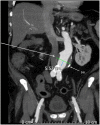Non coding RNAs in aortic aneurysmal disease
- PMID: 25883602
- PMCID: PMC4381652
- DOI: 10.3389/fgene.2015.00125
Non coding RNAs in aortic aneurysmal disease
Abstract
An aneurysm is a local dilatation of a vessel wall which is >50% its original diameter. Within the spectrum of cardiovascular diseases, aortic aneurysms are among the most challenging to treat. Most patients present acutely after aneurysm rupture or dissection from a previous asymptomatic condition and are managed by open surgical or endovascular repair. In addition, patients may harbor concurrent disease contraindicating surgical intervention. Collectively, these factors have driven the search for alternative methods of identifying, monitoring and treating aortic aneurisms using less invasive approaches. Non-coding RNA (ncRNAs) are emerging as new fundamental regulators of gene expression. The small microRNAs have opened the field of ncRNAs capturing the attention of basic and clinical scientists for their potential to become new therapeutic targets and clinical biomarkers for aortic aneurysm. More recently, long ncRNAs (lncRNAs) have started to be actively investigated, leading to first exciting reports, which further suggest their important and yet largely unexplored contribution to vascular physiology and disease. This review introduces the different ncRNA types and focus at ncRNA roles in aorta aneurysms. We discuss the potential of therapeutic interventions targeting ncRNAs and we describe the research models allowing for mechanistic studies and clinical translation attempts for controlling aneurysm progression. Furthermore, we discuss the potential role of microRNAs and lncRNAs as clinical biomarkers.
Keywords: aneurysms; biomarkers; long non-coding RNAs; microRNAs; therapeutic targets; vascular cells.
Figures



Similar articles
-
Role of Noncoding RNAs in the Pathogenesis of Abdominal Aortic Aneurysm.Circ Res. 2019 Feb 15;124(4):619-630. doi: 10.1161/CIRCRESAHA.118.312438. Circ Res. 2019. PMID: 30763215 Free PMC article. Review.
-
Noncoding RNAs in diabetes vascular complications.J Mol Cell Cardiol. 2015 Dec;89(Pt A):42-50. doi: 10.1016/j.yjmcc.2014.12.014. Epub 2014 Dec 20. J Mol Cell Cardiol. 2015. PMID: 25536178 Review.
-
Non-coding RNA Contribution to Thoracic and Abdominal Aortic Aneurysm Disease Development and Progression.Front Physiol. 2017 Jun 16;8:429. doi: 10.3389/fphys.2017.00429. eCollection 2017. Front Physiol. 2017. PMID: 28670289 Free PMC article. Review.
-
Long noncoding RNAs in key cellular processes involved in aortic aneurysms.Atherosclerosis. 2020 Jan;292:112-118. doi: 10.1016/j.atherosclerosis.2019.11.013. Epub 2019 Nov 21. Atherosclerosis. 2020. PMID: 31785492 Free PMC article. Review.
-
Non-coding RNAs in endometriosis: a narrative review.Hum Reprod Update. 2018 Jul 1;24(4):497-515. doi: 10.1093/humupd/dmy014. Hum Reprod Update. 2018. PMID: 29697794 Review.
Cited by
-
Pseudogenes in Cardiovascular Disease.Front Mol Biosci. 2021 Feb 10;7:622540. doi: 10.3389/fmolb.2020.622540. eCollection 2020. Front Mol Biosci. 2021. PMID: 33644114 Free PMC article. Review.
-
Circ_0022920 Maintains the Contractile Phenotype of Human Aortic Vascular Smooth Muscle Cells Via Sponging microRNA-650 and Promoting Transforming Growth Factor Beta Receptor 1 Expression in Angiotensin II-Induced Models for Aortic Dissection.J Am Heart Assoc. 2023 Apr 4;12(7):e027425. doi: 10.1161/JAHA.122.027425. Epub 2023 Mar 28. J Am Heart Assoc. 2023. PMID: 36974747 Free PMC article.
-
Construction of lncRNA-miRNA-mRNA networks reveals functional lncRNAs in abdominal aortic aneurysm.Exp Ther Med. 2018 Nov;16(5):3978-3986. doi: 10.3892/etm.2018.6690. Epub 2018 Sep 4. Exp Ther Med. 2018. PMID: 30344676 Free PMC article.
-
Lnc-C2orf63-4-1 Confers VSMC Homeostasis and Prevents Aortic Dissection Formation via STAT3 Interaction.Front Cell Dev Biol. 2021 Dec 6;9:792051. doi: 10.3389/fcell.2021.792051. eCollection 2021. Front Cell Dev Biol. 2021. PMID: 34938738 Free PMC article.
-
Pleural Empyema and Aortic Aneurysm: A Retrospective National Population-Based Cohort Study.Medicine (Baltimore). 2015 Nov;94(47):e2142. doi: 10.1097/MD.0000000000002142. Medicine (Baltimore). 2015. PMID: 26632741 Free PMC article.
References
Publication types
LinkOut - more resources
Full Text Sources
Other Literature Sources

